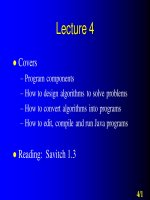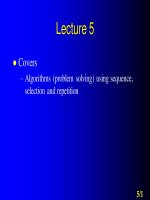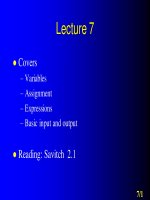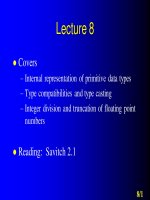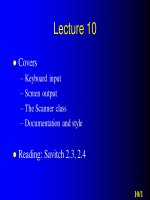Giáo trình Java cơ bản 22
Bạn đang xem bản rút gọn của tài liệu. Xem và tải ngay bản đầy đủ của tài liệu tại đây (532.49 KB, 44 trang )
Lecture 22
Covers
–
–
–
–
Programming with methods
Static attributes
Static methods
The Math class
Reading: Savitch 5.1, 5.2
22/1
Lecture overview
The this reference
Static attributes and static methods
More on the Math class
More on the main( ) method
22/2
► The this reference
22/3
The this reference
We can refer to an attribute or a method of
an object from without or from within
From without, we must specify both the
name that refers to the object, and the name
of the attribute or method
When we are referring to an attribute or
method in the same object, we refer to the
same object with a specially named
reference: this
22/4
The this reference
Therefore, we can refer to any attribute in
the same object as
this.<attribute>
And any method in the same object as
this.<method>
22/5
Omitting this
When we are referring to an attribute or
method in the same object, Java lets us leave
out the this
We can simply refer to an attribute in the same
object by
<attribute>
when there is no ambiguity (i.e. name conflict)
And invoke a method in the same object as
<method>
22/6
One common use of this
We often use this to distinguish the attribute from an
argument
Example
public void setHours(int hours)
{
if( 0 <= hours && hours <= 23)
{
this.hours = hours;
}
else
{
this.hours = 0;
}
}
22/7
► Writing methods using
helper methods
22/8
Handling complex methods
When a method is too long or too
complicated, it may be a good idea to break
it up into smaller methods
22/9
Example
Write a program that plays a guessing game with
the user
The program “thinks” of a number between 1 and
100 (inclusive) that the user has to guess
Each time the user guesses a number that is not
correct, the game indicates whether the number
they guessed is too high or too low
After the user has guessed the correct number, the
program displays how many guesses were
required
22/10
Example
I'm thinking of a number between 1 and 100.
Guess a number between 1 and 100 (inclusive): 50
That was too low!
Guess a number between 51 and 100 (inclusive): 12
Silly Duffer! That was way too low!
Guess a number between 51 and 100 (inclusive): 65
That was too high!
Guess a number between 51 and 64 (inclusive): 102
Silly Duffer! That was way too high!
Guess a number between 51 and 64 (inclusive): 58
That was too low!
Guess a number between 59 and 64 (inclusive): 63
That was too high!
Guess a number between 59 and 62 (inclusive): 60
That was too low!
Guess a number between 61 and 62 (inclusive): 61
You guessed 61 which was the right number!
It took you 8 guesses.
22/11
Designing a guessing game class
Each guessing game has the attributes
– numberToGuess
The number that the user “thinks” of
– numberOfTries
The number of guesses the user has had so far
– upperBound
The upper boundary of the current range in which
the user should be guessing (starts at 100)
– lowerBound
The lower boundary of the current range in which
the user should be guessing (starts at 1)
22/12
Designing a guessing game class
Each guessing game has a constructor that
– Sets the upper and lower boundary
– “Thinks” of a number
– Sets numberOfTries to 0 initially
Each guessing game has a method to play
the game
22/13
Define the class header
public class GuessingGame
{
}
22/14
Define the attributes
public class GuessingGame
{
private int numberToGuess;
private int numberOfTries;
private int upperBound;
private int lowerBound;
}
22/15
Define the constructor
public GuessingGame( )
{
numberToGuess = (int)(Math.random( ) * 100) + 1;
numberOfTries = 0;
upperBound = 100;
lowerBound = 1;
}
22/16
Math.random( )
Math.random( ) is a class method of the
Math class
It returns a pseudo-random number (a
double) between 0 and 1 (exclusive)
We can convert this “random” number to an
integer between 1 and 100 (inclusive)
22/17
Define the methods: playGame()
public void playGame( )
{
int guess;
boolean correctGuess = false;
System.out.println("I'm thinking of a number between "
+ lowerBound + " and " + upperBound + ".");
do
{
System.out.print("Guess a number between " + lowerBound
+ " and " + upperBound + " (inclusive): ");
guess = keyboard.nextInt( );
correctGuess = this.checkGuess(guess);
} while (!correctGuess);
System.out.println("You guessed " + guess
+ " which was the right number!");
System.out.println("It took you " + numberOfTries + " guesses.");
}
22/18
Helper methods
In the playGame( ) method of the
GuessingGame class, checking the guess
against the numberToGuess is done in a
helper method
We use helper methods to make our
programs easier to read and easier to manage
When defining a helper method, consider
whether you want it to be usable by any class
or only within the object itself.
22/19
Define the methods: checkGuess( )
private boolean checkGuess(int guess)
{
++numberOfTries;
if (guess == numberToGuess)
{
return true;
}
else if (guess < lowerBound)
{
System.out.println("Silly Duffer! That was way too low!");
}
else if (guess > upperBound)
{
System.out.println("Silly Duffer! That was way too high!");
}
22/20
checkGuess( )
else if (guess < numberToGuess)
{
System.out.println("That was too low!");
lowerBound = guess + 1;
}
else
{
System.out.println("That was too high!");
upperBound = guess - 1;
}
return false;
}
22/21
Alternative logic for checkGuess( )
if (guess == numberToGuess)
{
return true;
}
else
{
if (guess < lowerBound)
{
System.out.println("Silly Duffer! That was way too low!");
}
else if (guess > upperBound)
{
System.out.println("Silly Duffer! That was way too high!");
}
else if (guess < numberToGuess)
{
System.out.println("That was too low!");
lowerBound = guess + 1;
}
else
{
System.out.println("That was too high!");
upperBound = guess - 1;
}
return false;
}
22/22
Making helper methods private
We only want the checkGuess method to be
invoked by the method playGame which is
in the same object
We therefore restrict the access to
checkGuess by making it private
22/23
► Static attributes and static
methods
22/24
Extension
Suppose we are going to write a program to
play the game several times, and we want to
know the average number of guesses we
made per game (for that run of the program)
We can do that by having
– an attribute to count the number of games we
play and
– an attribute to count the total number of guesses
we make
22/25




